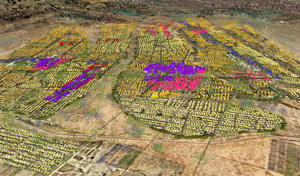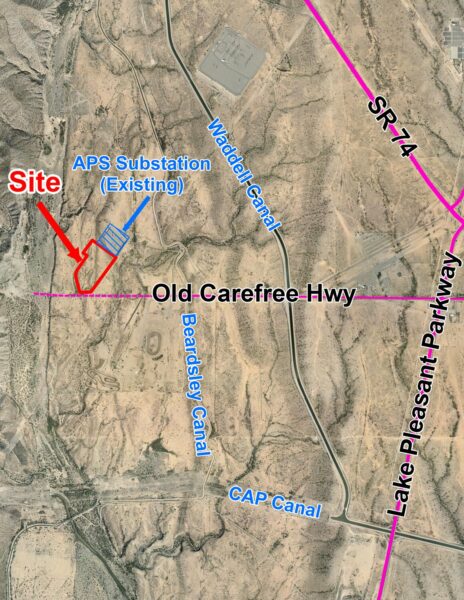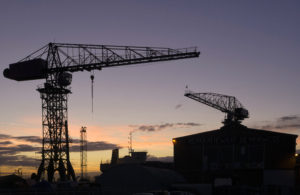By Catherine Reagor | The Arizona Republic
A site in northern Pinal County between Apache Junction, the Superstition Mountains, Queen Creek and Florence, lures developers again. The State Land Department plans to sell 7,000 acres that were part of the original Superstition Vistas land plan.
The area around it is primed for development, but with obstacles. More than 11,000 acres south and east of Superstition Vistas were purchased for $118 million in December.
“Superstition Vistas should be drawing attention now, and we should actively be planning growth there,” Mark Stapp, director of the Master of Real Estate Development program in the W.P. Carey School at Arizona State University, told The Arizona Republic. “But it’s a huge site, and there are many obstacles toward its development, starting with transportation.”
Except for cattle and desert-dwelling wildlife, the 275 square miles of state-trust land is virtually uninhabited. Developers have leapfrogged the vast tract and built farther south in Pinal County.
The state-owned land is known as Superstition Vistas, and parcels within it soon will be on the market. But not for the first time.
Almost a decade ago, the raw desert seemed ripe for development. Planners suggested it might be a major Phoenix suburb, similar to what Orange County’s Irvine, Calif., is to Los Angeles. Tens of thousands of people would live there by 2050, they said.
2006 report: Where we grow next
In 2005, a group including urban planners, conservationists, utilities and government entities banded together to commission Arizona State University’s Morrison Institute to craft growth scenarios for the area, which is bigger than Mesa, Gilbert, Tempe and most of Chandler combined.
The goal: Offer a blueprint to build a cohesive community, with good jobs, parks, infrastructure and transportation. A plan that would come ahead of all the housing rooftops, not behind it.
The plan, unveiled with ceremony in 2006, sat ignored as the housing market crashed. Over the next few years, proposals that would have updated the Arizona State Land Department’s operating laws, which could have helped the agency plan and sell the parcel, failed in the Legislature and at the ballot box.

Taking a massive swath of desert largely without roads, power and water and turning it into a livable, sustainable community is a daunting task, especially with no ground rules in place. Transportation and land planning remain major issues for the area, along with the usual metro Phoenix worries about water availability and economic development.
Unless state laws change, parcels within the area must be sold to the highest bidder at auction, which means developers are in the driver’s seat on land planning and Pinal County officials will likely decide the zoning.
“You can continue to develop one half-section at a time, or you can look at all 275 square miles of Superstition Vistas as a whole,” said Sandie Smith, a former Pinal County supervisor and a player in early discussions of Superstition Vistas.
Roads, roads, roads
Today, Pinal County has 390,000 residents. Forecasts envision 600,000 in 2025 and as many as 900,000 by midcentury.
Planners say Pinal County and Superstition Vista’s future growth depend on Arizona’s ambitious but unfunded transportation plans. U.S. 60 and Arizona 79 bisect the area, but it is remote from existing freeways.
Developers of the types of job-creating projects Pinal County is trying to attract need good infrastructure, particularly navigable roads and rails for their plans to pencil out.
Currently, there are proposals for a freeway called Interstate 11 to connect Casa Grande with Las Vegas, a passenger-rail link from Phoenix to Tucson via Florence and an eastern extension of Arizona 24 beyond Phoenix-Mesa Gateway Airport into Pinal County. The most vital project to Superstition Vistas is a highway dubbed “the North-South Freeway,” linking U.S. 60 to I-10 past Florence.
Vanessa Hickman, state land commissioner, said her office is working with municipalities and others with interests in Superstition Vistas on an effort to route the North-South Freeway through Superstition Vistas.
Pinal County Economic Development Director Tim Kanavel said, “The North-South Freeway is critical. It opens it all up for development.”
No public or taxpayer money has been allocated to build any of the freeways yet. But Pinal County leaders and Arizona Department of Transportation officials say the existing road network cannot keep up with expected demand.
Money is the issue, Sandie Smith said.
“All this goes back to public will. How much are they willing to pay for transportation?” she said.
ADOT has identified the North-South Freeway as one of the leading candidates as a potential toll road, under the state’s new law to allow private investment in public projects. It could become Arizona’s first toll road.
Sandie Smith, now CEO of the Pinal Partnership, said she knows what the alternative to planned growth looks like: Hunt Highway.
As San Tan Valley tops 90,000 residents, the two-lane highway, which has served as the only major road in and out for years, is finally getting widened. For years it has been a dangerous bottleneck because unplanned residential growth outstripped the capacity of the road.
No master plan
Superstition Vistas has been on planners’ and developers’ minds for more than a decade. The metro area has crept ever closer, but the tract also borders thousands of acres of public lands, including the Superstition Wilderness Area. Its total land value is estimated in the billions of dollars.
Sensing its immense value, many didn’t want the development mistakes made in the San Tan Valley to be repeated across more desert.
The cities closest to the huge parcel, along with Pinal County, Salt River Project, Central Arizona Project and the Sonoran Institute, paid the Morrison Institute $200,000 to present its recommendations.
The Morrison Institute study, titled “The Treasure of the Superstitions,” coined the term Superstition Vistas.
It laid out three suggestions to develop a planned community compatible with the desert.
• Thinking big: Before homes are built, complete infrastructure including freeways, roads, utility lines, drainage corridors and open space.
• Simple green: Create a sustainable community that uses less water and power.
• Superstitionville: Establish a city government before development begins. An appointed council would create a detailed plan for the area’s growth.
The plan, however, came with an asterisk. It would be difficult to implement under existing state law.
Under policies set in the early 20th century, the State Land Department must sell to the highest bidder, even if another group has a better plan or financing.
The rule, in general, has kept parcel sizes relatively small, in comparison to a huge area such as Superstition Vistas. Few developers have the money to buy and plan such a vast amount of acreage.
Attempts to change state-land laws have failed several times. The state agency still must sell land to the highest bidder at auction. It must rely on developers who pay for land planning and take the chance they may not be the winning bidders.
The state agency has little money to plan and zone Superstition Vistas or plan or market the nearly 9 million other acres it manages and sells to help support the Arizona education system.
Before the housing crash, the Australian firm Lend Lease, an international developer with deep pockets, had been recruited to be the initial land buyer and planner for more than 8,000 acres in Superstition Vistas. The developer was part of the early planning.
But Las Vegas homebuilder Jim Rhodes outbid Lend Lease at the 2007 auction, much to the consternation of Superstition Vistas planners.
Last year, Rhodes developed part of the first 1,000 acres of the land and then defaulted on his deal to buy an additional 7,000 acres. The State Land Department is getting ready to go to auction with it again.
“It’s got to be the time now for developing Superstition Vistas. Other projects are already leapfrogging over it,” said Mark Winkleman, a real-estate attorney who was state land commissioner when the Morrison report was published.
“The Land Department needs the resources and ability to do a good job and work with developers willing to spend the money and plan for a big piece of land like Superstition Vistas.”
Growth ambitions
Pinal County’s political and business leaders have long wanted the county to shed its stereotype as a place for rooftops, prisons, agriculture and high unemployment. They are banking on much-better-planned development in Superstition Vistas to attract high-end housing and major employers paying higher wages.
In a county where 57 percent of the workforce works in another county, Superstition Vistas, planned properly, could be the lightning rod to correct that imbalance. The prospect of a new city north of Florence allows the county to market itself to developers by promising that many more people will live and work within a 50-mile radius.
Prospective projects promise to reshape central Pinal County as a hub for freight, logistics and light manufacturing, and the result is real optimism. The county forecasts 15,000 good-paying jobs will be created as a result.
The list includes plans by Union Pacific Corp. for a switching yard near Red Rock, private development of an inland port near Eloy on land assembled in the largest single purchase in county history this year, and improvements to the Pinal Airpark to the south.
“We are getting looks from projects that, five years ago, they wouldn’t have blinked at us,” Kanavel said.
Pinal Land Holdings, a newly formed investment group, paid $118 million for 11,400 acres in Coolidge and Eloy. Land analysts say development of the property, which was purchased from Mesa, is a key step in connecting metro Phoenix to the southern reaches of Pinal County.
Pinal County officials aren’t pitching Superstition Vistas to Tesla Motors, which is looking at sites in four states for its $4 billion battery factory that would employ 6,500. The land has no infrastructure yet. Instead, they are pushing a site owned by Pinal Land and two others alongside I-10.
“We’re in a great spot for Tesla,” said company CEOJackob Andersen, noting he can accommodate a 1,000-acre industrial site, with room to expand, and supply power, water and rail.
Whether Tesla opts for Pinal, the central location is still attractive for freight, logistics and warehouse operations, he said.
Unresolved questions
Neither developers nor companies such as Tesla will line up to bid on land in Superstition Vistas until the key infrastructure — roads, power and water supply — is in place. And the planning issues remain unresolved.
The land is in Salt River Project territory, and the utility has been active in trying to plan Superstition Vistas. But it’s not clear who would handle the area’s water. George Johnson has the exclusive contract for Pinal County’s water service.
The two main sources of transportation money, federal and state gas taxes, are barely able to keep up with maintaining existing roads. Congressional transportation spending has been treading water for decades. The state Legislature has routinely taken money from dedicated transportation funds to balance Arizona’s overall budget.
Ongoing discussions continue over Apache Junction, Mesa and Florence potentially annexing parts of Superstition Vistas. But there is no formal movement to try to reform the 100-year-old laws setting out how the State Land Department must operate. Many backers of past reform movements, including Arizona real-estate attorney and growth expert Grady Gammage, have given up on it.
“I think we move on from Land Department reform and try to get as creative as possible to use state land as an economic-development tool and develop it for the best uses,” Gammage said.
Even with the uncertainties, Hickman said developers recently have expressed interest in Superstition Vistas. Although the 7,000-acre parcel Rhodes defaulted on could be sold this year, it could be a few years before most of the land is purchased, she said.
All of Arizona’s big developers are looking at Superstition Vistas, but none appears ready to make a bid yet.
“We have conducted a lot of valuable research on Superstition Vistas, but the market hasn’t recovered enough for the kind of development the area needs,” said Maria Baier, CEO of Tucson-based growth-planning group Sonoran Institute and the state land commissioner before Hickman.
“The site is extremely important for Arizona’s future landscape, but it just doesn’t seem like anything has jelled to move its development forward yet.”
Superstition Vistas
The metro area has crept ever closer, but the 275-square-mile state-owned tract also borders thousands of acres of public lands, including the Superstition Wilderness Area. Total land value of the parcel is estimated in the billions of dollars.











